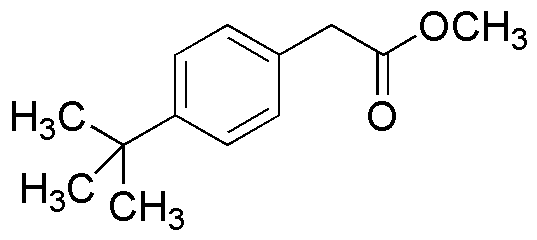Methyl p-tert-butylphenylacetate is widely utilized in research focused on various practical applications:
- Fragrance Industry: This compound is commonly used as a fragrance ingredient in perfumes and personal care products, providing a pleasant scent due to its aromatic properties.
- Flavoring Agent: It serves as a flavoring agent in food products, enhancing taste profiles, particularly in confectionery and beverages.
- Solvent in Chemical Reactions: Methyl p-tert-butylphenylacetate acts as a solvent in organic synthesis, facilitating reactions by dissolving reactants and improving yield.
- Polymer Production: It is utilized in the production of specialty polymers, contributing to materials with desirable properties such as flexibility and durability.
- Research Applications: In laboratories, it is used as a standard in analytical chemistry, aiding in the calibration of instruments and ensuring accurate measurements.
General Information
Properties
Safety and Regulations
Applications
Methyl p-tert-butylphenylacetate is widely utilized in research focused on various practical applications:
- Fragrance Industry: This compound is commonly used as a fragrance ingredient in perfumes and personal care products, providing a pleasant scent due to its aromatic properties.
- Flavoring Agent: It serves as a flavoring agent in food products, enhancing taste profiles, particularly in confectionery and beverages.
- Solvent in Chemical Reactions: Methyl p-tert-butylphenylacetate acts as a solvent in organic synthesis, facilitating reactions by dissolving reactants and improving yield.
- Polymer Production: It is utilized in the production of specialty polymers, contributing to materials with desirable properties such as flexibility and durability.
- Research Applications: In laboratories, it is used as a standard in analytical chemistry, aiding in the calibration of instruments and ensuring accurate measurements.
Documents
Safety Data Sheets (SDS)
The SDS provides comprehensive safety information on handling, storage, and disposal of the product.
Product Specification (PS)
The PS provides a comprehensive breakdown of the product’s properties, including chemical composition, physical state, purity, and storage requirements. It also details acceptable quality ranges and the product's intended applications.
Certificates of Analysis (COA)
Search for Certificates of Analysis (COA) by entering the products Lot Number. Lot and Batch Numbers can be found on a product’s label following the words ‘Lot’ or ‘Batch’.
*Catalog Number
*Lot Number
Certificates Of Origin (COO)
This COO confirms the country where the product was manufactured, and also details the materials and components used in it and whether it is derived from natural, synthetic, or other specific sources. This certificate may be required for customs, trade, and regulatory compliance.
*Catalog Number
*Lot Number
Safety Data Sheets (SDS)
The SDS provides comprehensive safety information on handling, storage, and disposal of the product.
DownloadProduct Specification (PS)
The PS provides a comprehensive breakdown of the product’s properties, including chemical composition, physical state, purity, and storage requirements. It also details acceptable quality ranges and the product's intended applications.
DownloadCertificates of Analysis (COA)
Search for Certificates of Analysis (COA) by entering the products Lot Number. Lot and Batch Numbers can be found on a product’s label following the words ‘Lot’ or ‘Batch’.
*Catalog Number
*Lot Number
Certificates Of Origin (COO)
This COO confirms the country where the product was manufactured, and also details the materials and components used in it and whether it is derived from natural, synthetic, or other specific sources. This certificate may be required for customs, trade, and regulatory compliance.


